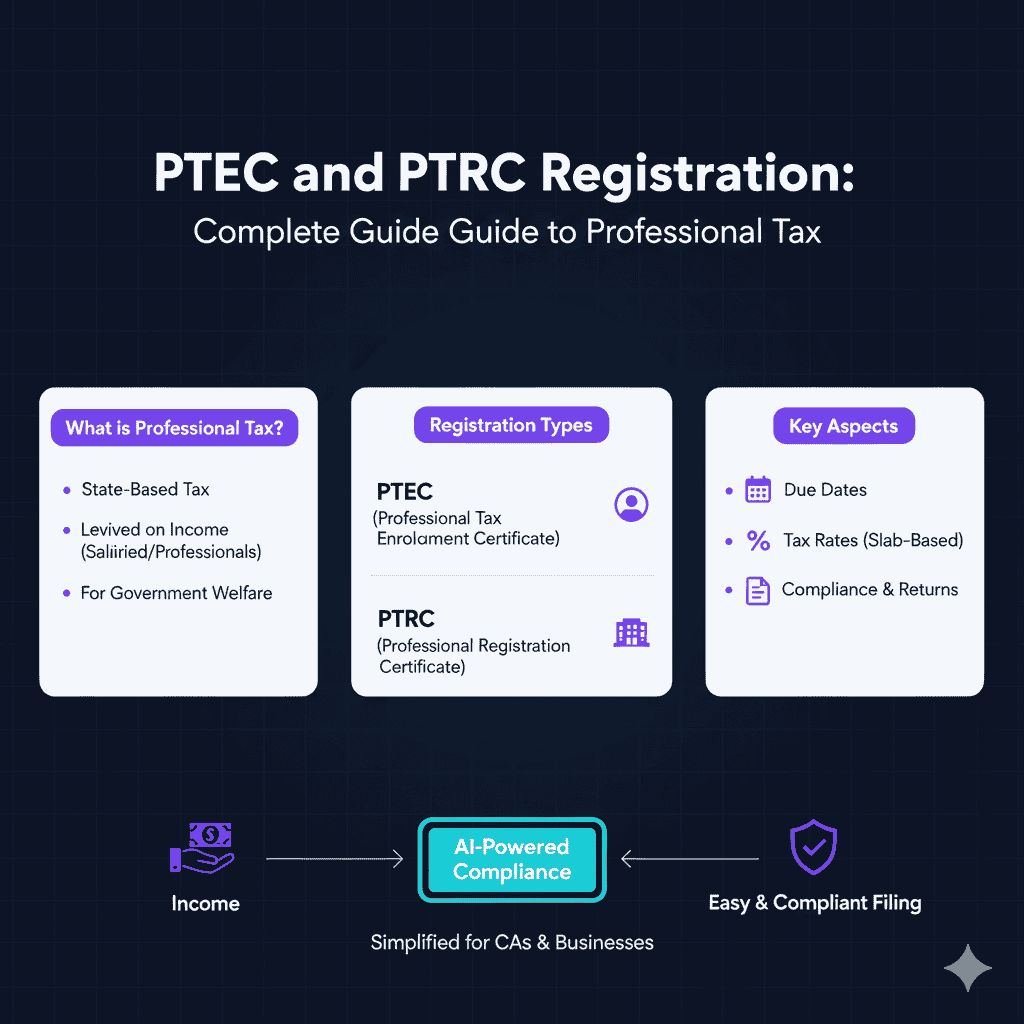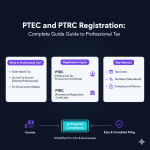Professional Tax is one of many taxes that every business, professional, or employer must pay in India. It is a small but necessary tax that state governments impose on incomes derived from professions, trades, and employment.
PTEC (Professional Tax Enrollment Certificate) refers to the self employed individuals and business owners who pay the tax on their own.
PTRC (Professional Tax Registration Certificate) indicates employers who deduct and deposit the Professional Tax on their employees’ behalf.
Both registrations are regulated by professional tax laws of the respective states, and the procedure, due dates, and tax slabs may be different in each state. Knowing the difference between the two registrations is the key to being compliant with the rules and staying away from the risk of penalties.
What Is Professional Tax?
Professional tax (PT) is a tax that the state levies on the net income of individuals who are engaged in a profession, trade, or calling or are employed. As opposed to the income tax, which the central government imposes, professional tax is a tax that state governments impose and collect under their laws.
The tax is also applicable to self employed professionals such as doctors, consultants, freelancers, chartered accountants, lawyers, and business owners as well as employees. In short, anyone who earns a lawful income through a profession or business is required to pay professional tax.
Who Has to Pay Professional Tax
Employers: They must ensure the deduction of professional tax from their employees’ salaries on a monthly basis and the deposit of the same with the government through PTRC registration.
Self Employed Individuals or Business Owners: The requirement is to register and pay the tax for their account under PTEC registration.
Why Professional Tax is Necessary
Professional tax is a state level compliance requirement like GST or income tax filings, however, it is directed only to professions and trades. Not obtaining registration or paying the due tax can cause to penalize, to be charged for interest, and as well as to be disqualified for some business registrations.
Though the tax slabs and regulations have differences from one state to another, the highest total professional tax amount that can be charged to an individual during a financial year is ₹2,500, as limited by the Constitution of India.
Getting the right professional tax registration (whether PTEC or PTRC) is a way of ensuring that your firm is in the clear, that it is not subject to any penalty, and that it can continue to operate smoothly even when it has to face tax inspections or audits.
What Is PTRC Registration?
The term PTRC is an abbreviation of the Professional Tax Registration Certificate.
It is a registration that is required when a workforce holder is an employer who is doing the deduction and the payment of the Professional Tax (PT) on behalf of the employees.
So to say, if you are running a business or organization and have paid staff under you, the law requires you to have a PTRC registration for you to be able to deduct professional tax from their salaries and remit it to the state government concerned.
Who Needs PTRC Registration?
You are obliged to get a PTRC registration if:
In the case, you are employing one or more salaried individuals in your business.
You are deducting Professional Tax from your employees’ monthly salary.
If you are an organization, firm, company, LLP, or establishment paying wages or remuneration to the staff.
Small and medium businesses, too, are within the ambit of this ruling. A PTRC registration becomes a must at the point when you begin to employ people.
Difference Between PTRC and PTEC
Although PTRC and PTEC both fall under Professional Tax registration, they serve different purposes and apply to different taxpayers.
Understanding the distinction between the two helps businesses and professionals determine which registration(s) they need to stay compliant.
| Basis | PTEC (Professional Tax Enrollment Certificate) | PTRC (Professional Tax Registration Certificate) |
|---|---|---|
| Applicability | For self-employed individuals, business owners, and professionals who pay Professional Tax for themselves. | For employers who have salaried employees and deduct Professional Tax from their salaries. |
| Purpose | To pay Professional Tax on your own income. | To deduct and deposit Professional Tax on behalf of employees. |
| Who Needs It | Proprietors, freelancers, consultants, directors, and companies (for their own liability). | Any entity or employer paying salaries to employees. |
| Nature of Tax | Self-assessment – you pay for your own income. | Collected from employees – you deduct and remit to the state. |
| Filing Frequency | Generally annual (depends on state rules). | Monthly or quarterly, depending on the number of employees. |
| Certificate Type | Professional Tax Enrollment Certificate. | Professional Tax Registration Certificate. |
| Responsibility | Individual or business entity. | Employer or organization. |
| Example | A freelance consultant paying tax for themselves. | A company deducting PT from staff salaries every month. |
Summary
- PTEC is for self-employed individuals and business entities to pay tax on their own professional income.
- PTRC is for employers to deduct and remit tax collected from employees’ salaries.
- Businesses that both earn income and employ staff must obtain both PTEC and PTRC registrations.
Failing to register under the correct category may lead to penalties, interest, and compliance issues during tax or labor inspections.
PTEC Registration Process (Step-by-Step)
Registering for PTEC (Professional Tax Enrollment Certificate) is a straightforward process that can be completed entirely online through the official state tax portal.
Here’s a detailed breakdown of each step to help you complete the process smoothly.
Step 1: Visit the Official Website
Go to the State Government’s GST or Professional Tax portal (for example, in Maharashtra it’s https://mahagst.gov.in).
From the homepage, choose “New Registration” → “Professional Tax (PTEC)” option.
Step 2: Create a User Account
Enter your PAN, mobile number, and email ID to create a login.
You’ll receive an OTP verification to confirm your credentials.
Once verified, you can log in to the registration dashboard.
Step 3: Fill in the Application Form
Provide all the required business and personal details, such as:
- Applicant’s Full Name and PAN
- Business Name, Type, and Address
- Nature of Profession or Activity
- Date of Commencement of Business
- Contact and identification details
Ensure that the information matches your PAN and GST records to avoid rejection.
Step 4: Upload the Required Documents
You’ll need to upload soft copies (PDF or JPEG) of supporting documents such as:
- PAN Card of applicant or business entity
- Proof of Address (electricity bill, rent agreement, etc.)
- Identity Proof (Aadhaar or Passport)
- Certificate of Incorporation / Partnership Deed / Shop Act License
- Cancelled Cheque or Bank Statement (for account verification)
Step 5: Submit the Application
After reviewing all details and uploading documents:
Click on “Submit” to complete the registration.
You will receive an Application Reference Number (ARN) for tracking.
Step 6: Pay the PTEC Fees
Once your application is approved:
Log in to your account and proceed to “Make Payment” under the PTEC section.
Pay the Professional Tax amount (usually ₹2,500 per year) through online banking, debit/credit card, or challan.
Step 7: Download Your PTEC Certificate
After successful payment:
You can download your PTEC Certificate directly from your dashboard.
This certificate serves as proof of registration and must be kept safely for compliance checks or audits.
Important Notes
PTEC registration is typically approved within 1–2 working days, depending on document verification. The certificate remains valid for lifetime, but annual payment of tax is mandatory.
Documents Required for PTEC Registration
Before filing an application for PTEC registration, trying to gather certain documents for easy verification and approval will be a great idea. Depending on the state, there might be a slight difference in the list of exact requirements, but most states have a similar list of documents.
Documents required for PTEC Registration
One of the documents required is the constitution of the business along with the certificate of incorporation, partnership deed, or the proof of proprietorship.
- Proof of business constitution such as Certificate of Incorporation, Partnership Deed, or proof of Proprietorship
- PAN card of the business entity or individual applicant
- Address proof like an electricity bill, rent agreement, or property tax receipt
- Identity proof of the owner, partner, or director such as Aadhaar or PAN
- Cancelled cheque or latest bank statement for verifying bank details
Certain states may also require registration certificates under GST, Shops and Establishments, or MSME for their cross verification.
It is recommended that all files be clear, valid, and in PDF or JPEG format, depending on the size, as per the state portal.
PTEC Registration Fees
Once you complete the registration process, you must pay a nominal annual professional tax to keep your PTEC certificate active. The exact amount of tax varies depending on the state where you are registered, but it is usually capped at a maximum of ₹2,500 per year as per government regulations.
The transaction can be done on the concerned state tax portal via net banking, debit or credit card, or by a generated challan. A few states have also enabled the facility to pay the advance for several years at a time.
Is PTEC Compulsory for GST Registration?
In most states, businesses that apply for GST registration are also required to obtain a PTEC registration. This is because professional tax applies to anyone earning income through a business, profession, or trade, including GST-registered entities.
During the GST registration process, some state portals even auto-verify or prompt applicants to apply for PTEC simultaneously. Not having a valid PTEC certificate may delay other state-level registrations or result in compliance issues later.
Even if your business does not have employees, a PTEC registration ensures compliance with professional tax laws and demonstrates that your enterprise is properly enrolled under all applicable state tax systems.
To summarize, while GST and PTEC serve different purposes, obtaining both registrations is generally mandatory for businesses to remain fully compliant.
Frequently Asked Questions (FAQ)
What is the full form of PTEC?
PTEC stands for Professional Tax Enrollment Certificate. It is issued to individuals, professionals, and business owners who are liable to pay professional tax in their own name.
What is the full form of PTRC?
PTRC stands for Professional Tax Registration Certificate. It is required for employers who deduct and pay professional tax on behalf of their employees.
Is PTEC registration compulsory for all businesses?
Yes, every person or entity engaged in a profession, trade, or business is required to obtain PTEC registration, even if they do not have employees.
Can I apply for PTEC registration online?
Yes, PTEC registration can be completed online through the official state tax portal. The process involves filling an application form, uploading documents, and paying the prescribed fee.
What is the annual PTEC payment amount?
The professional tax amount under PTEC is generally capped at ₹2,500 per financial year, though exact slabs may vary from state to state.
Can one application be used for both PTEC and PTRC registration?
Yes, many states allow applicants to apply for both PTEC and PTRC through a single online form. You just need to select both options while filling out the registration details.
Can I cancel or surrender my PTEC registration?
Yes, if a business or professional stops operating, they can apply to cancel their PTEC registration through the same state portal. Proper documentation and a final tax payment are usually required before the certificate is surrendered.




